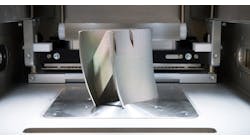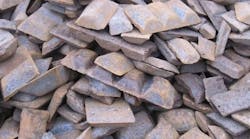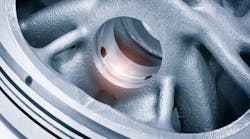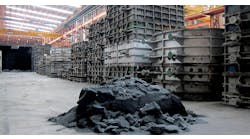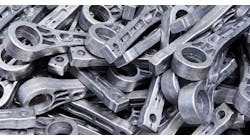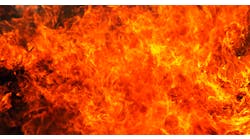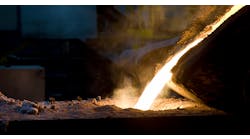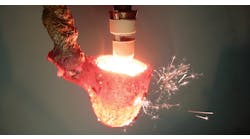High-volume foundries and diecasters typically commit themselves to particular markets, like automotive OEMs and their suppliers. In those cases, they are producing castings in lightweight aluminum alloys, and the proportion of aluminum in cars continues to rise. Without even counting forecasts for electric vehicles, the proportion of aluminum per car is now around 140 kg. For metalcasters to produce as economically and resource-efficiently as possible, recycling of scrap parts and casting residues is increasingly important.
That is the need for which Erdwich Zerkleinerungs-Systeme GmbH is offering its scrap-shredding machines: the RM 1350/2 twin-shaft ripper and the M600/1 single-shaft shredder can be integrated into production lines to help establish automated scrap recycling operations. As described by EZS, recycling of scrap parts then becomes the first step in the foundry’s production cycle.
Even in production-optimized foundries, it is impossible to avoid defective castings, casting residues, and other material waste in the manufacturing process. The trend toward lightweight automotive design and construction has prompted an increase in demand for aluminum, and the quantity of scrap material has increased accordingly. Traditionally, sprue systems and defective castings were collected in containers until a sufficient quantity was available for recycling and remelting: now, more efficient methods are needed.
In view of rising raw-material prices, it is also in the foundries’ interest to return scrap material to the production process as quickly and efficiently as possible. To support energy-efficient remelting, the parts must be shredded.
Demand-oriented shredding — Defective castings for gearbox housings or entire engine blocks, as well as axle bearings, battery housings, and sprue spiders, are among the challenges that a reprocessing system has to manage. The Erdwich Zerkleinerungs-Systeme RM1350/2 twin-shaft ripper and M600/1 single-shaft shredder are up to the task. Both systems can be retrofitted into production lines to shred the rejects directly where they are produced.
Then, the right-sized parts can be transported directly back to the furnace systems via conveyor belts or collected in containers. The volume of cast parts is reduced by 50 to 60%, eliminating the need for intermediate storage of the scrap material. The RM 1350/2 has a variable cutting unit, 1,350 mm wide and 1,500, 2,000, or 2,500 mm long. The cutting knives are made of low-wear, special steel and can be inserted individually according to different cutter sequences, depending on the material to be shredded. This means the knives can be prepared or sharpened as required without having to remove the entire shaft.
Depending on the application, drive loads from 45 to 132 kW can be selected to achieve a throughput of 1.5 to 5 metric tons/hour. The machine control also allows alternating forward and reverse motion of the shafts to increase throughput for bulky parts. The specially developed PLC control, with automatic reversing and switch-off, protects the machine from damage caused by overload should bulky components jam in the ripper.
Integration production — Erdwich will customize the sizing and other details for the shredding units in order to optimize the placement into production lines, to achieve the desired efficiency of integrated operation. A constructive solution is worked out that makes optimal use of the available space and provides the necessary sizes for the plant’s volume. The machine is integrated into complete production lines as a fully automated solution to ensure that shredded materials are returned to the production process as quickly as possible. Return of metal parts is carried out either via conveyor belts, or by collecting them in containers, and then are melted down again.
Shredding also means that energy consumption for melting can be reduced, as small or right-sized parts can be melted down more easily and quicker. Reprocessing of the scrap parts thus becomes the first production step in an energy-efficient and cost-saving metalcasting production cycle.